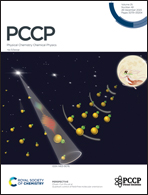Revisiting the bonding of the pentagonal-pyramidal C6H62+ and C6(CH3)62+ dications†
Abstract
This work delves into the bonding nature of the pentagonal-pyramidal benzene and hexamethylbenzene dications, C6R62+ (R = H and CH3), which contain a hexacoordinate carbon. The study employs a range of methodologies to analyze a series of scalar fields, including electron density, electron localization function, local momentum representation, and the evaluation of the Coulomb hole through information theory-derived functions. The findings unveil that electron density undergoes transfer from the pentagonal ring to the apical group. As a result, the base of the complex accumulates the positive charge. Moreover, an extended electron density domain emerges between the carbon pentagon and the apical carbon atom. This phenomenon is related to the molecular orbitals with a dipolar character aligned with the principal axis of the molecule. The results also indicate an electron density polarization towards the apical carbon, coupled with an exclusion of electron density surrounding both the apical carbon and the lower portion of the pentagonal ring. These provide valuable insights into the complex bonding nature of hexacoordinate carbon and its implications for organic chemistry.



 Please wait while we load your content...
Please wait while we load your content...